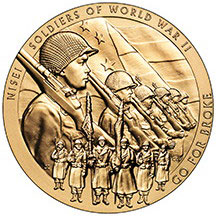
post-1946- Home
- History
- Historical Timeline
- Post-1946
- Home
- History
- Historical Timeline
- Post-1946
Historical Timeline: 1947-Present
1947
December: President Harry Truman pardons all draft resisters from World War II, including 267 Japanese Americans, many from the Heart Mountain incarceration center in Wyoming.
1948
January: US Supreme Court overturns the Fred Oyama v. California case ruling, essentially deeming unconstitutional a key provision of the Alien Land Law that denied Issei from gifting land to their US citizen children.
July: President Truman signs the Japanese American Evacuation Claims Act, which compensates Japanese Americans for ten cents on the dollar for economic losses from the loss of property due to their forced removal.
The President also signs Executive Order 9981, establishing equality of treatment and opportunity in the Armed Forces.
1952
April: In Sei Fuji v. California, the California Supreme Court declares the Alien Land Law unconstitutional.
June: Congress passes the Walter-McCarran Immigration and Nationality Act, overturning President Truman’s veto. Despite restrictive immigrant quotas, the Act enables Asian immigrants to become naturalized citizens.
1959
August: Hawaii becomes the fiftieth state. Hawaii’s Nisei veterans play a crucial role.
Daniel K. Inouye, 442nd RCT veteran, becomes the first Japanese American elected to the House of Representatives
1962
November: Daniel K. Inouye becomes the first Japanese American US senator, representing Hawaii. An original member of the 100th Infantry Battalion (Separate) and 442nd RCT, Spark Matsunaga, becomes a US congressman from Hawai’i.
1965
January: Patsy Takemoto Mink becomes the first ethnic minority woman and the first Asian American woman elected to the US House of Representatives.
March: The first American combat troops arrive in Vietnam to defend the US airfield at Danang. Both Nisei and Sansei serve at the advisory and combat levels during the conflict that began in the 1950s.
October:
President Lyndon B. Johnson signs Public Law 89-236, which amends the Immigration and Nationality Act, abolishing “national origins” as the basis for immigration quotas. Asian countries are thereby treated equally as European countries in immigration matters for the first time in US history.
1976
February: President Gerald Ford signs Proclamation 4417, “An American Promise,” rescinding Executive Order 9066.
1980
July: President Jimmy Carter signs a bill to create the Commission on Wartime Relocation and Internment of Civilians (CWRIC) which is tasked to study the mass removal and incarceration of Japanese Americans during World War II and to recommend an appropriate remedy.
1983
June: In their 467-page report, “Personal Justice Denied,” CWRIC concludes that the incarceration of Japanese Americans was unjustified and based on “race prejudice, war hysteria and a failure of political leadership.” It calls for Congress to issue an apology and offer $20,000 compensation to each of the estimated 60,000 survivors.
November:
Federal court in San Francisco nullifies Fred Korematsu’ original conviction, ruling that the government unjustly issued orders for mass removal and incarceration.
1984
California State Legislature proclaims February 19, 1984, the first “Day of Remembrance” commemorating the incarceration of Japanese immigrants and Americans of Japanese descent.
1985
October: Federal District Court in Portland, Oregon, vacates Minoru Yasui’s 1942 conviction for violating curfew during World War II.
1986
February: Federal District Court in Seattle, Washington, nullifies Gordon Hirabayashi’s 1942 conviction for violating wartime incarceration orders.
1988
August: President Ronald Reagan signs the Civil Liberties Act of 1988, requiring the payment of $20,000 and the issuance of an apology to the estimated 60,000 survivors of incarceration. It also establishes the Civil Liberties Public Education Fund and the Office of Redress Administration (ORA).
1990
October: President George Bush presents the first letters of apology and $20,000 redress payments to the oldest survivors of the World War II incarceration, now numbering 80,000.
1999
February: The Office of Redress Administration (ORA) officially closes, having distributed redress payments to more than 82,000 incarceration survivors and their heirs.
June: The Go For Broke Monument honoring Nisei soldiers of World War II and others serving in the military is officially dedicated in Los Angeles, California.
July: Norman Mineta, Korean War veteran and former Heart Mountain incarceree, is confirmed as the Secretary of Commerce, becoming the first Asian American appointed by the President to the Cabinet.
November: The Japanese American Memorial to Patriotism During World War II is dedicated in Washington, DC.

















